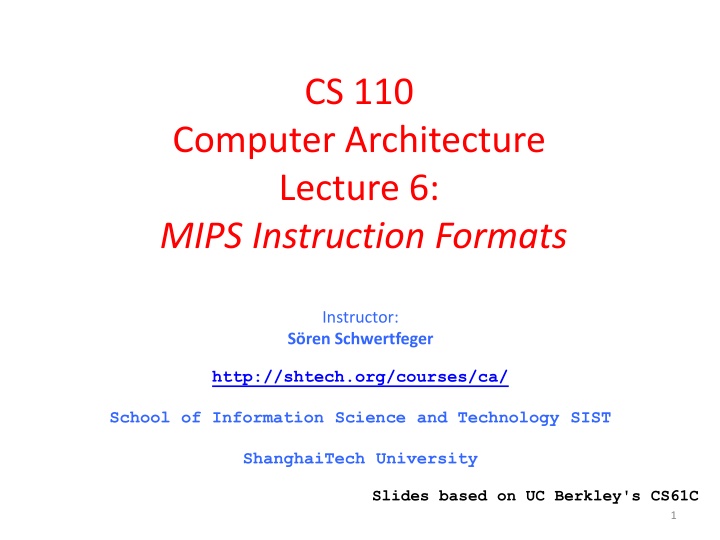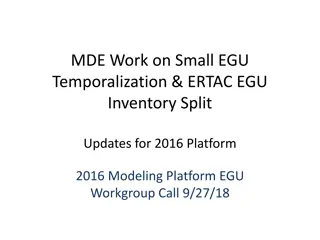
MIPS Instruction Formats and Levels of Representation
Explore MIPS instruction formats, levels of representation in computer architecture, stack allocation, recursive functions like factorial, and hardware architecture interpretation in this informative lecture slide excerpt from ShanghaiTech University.
Download Presentation

Please find below an Image/Link to download the presentation.
The content on the website is provided AS IS for your information and personal use only. It may not be sold, licensed, or shared on other websites without obtaining consent from the author. If you encounter any issues during the download, it is possible that the publisher has removed the file from their server.
You are allowed to download the files provided on this website for personal or commercial use, subject to the condition that they are used lawfully. All files are the property of their respective owners.
The content on the website is provided AS IS for your information and personal use only. It may not be sold, licensed, or shared on other websites without obtaining consent from the author.
E N D
Presentation Transcript
CS 110 Computer Architecture Lecture 6: MIPS Instruction Formats Instructor: S ren Schwertfeger http://shtech.org/courses/ca/ School of Information Science and Technology SIST ShanghaiTech University Slides based on UC Berkley's CS61C 1
Levels of Representation/Interpretation temp = v[k]; v[k] = v[k+1]; v[k+1] = temp; High Level Language Program (e.g., C) Compiler lw $t0, 0($2) lw $t1, 4($2) sw $t1, 0($2) sw $t0, 4($2) Anything can be represented Assembly Language Program (e.g., MIPS) as a number, i.e., data or instructions Assembler 0000 1001 1100 0110 1010 1111 0101 1000 1010 1111 0101 1000 0000 1001 1100 0110 1100 0110 1010 1111 0101 1000 0000 1001 0101 1000 0000 1001 1100 0110 1010 1111 Machine Language Program (MIPS) Machine Interpretation Hardware Architecture Description (e.g., block diagrams) Architecture Implementation Logic Circuit Description (Circuit Schematic Diagrams) 2
Review: Allocating Space on Stack C has two storage classes: automatic and static Automatic variables are local to function and discarded when function exits Static variables exist across exits from and entries to procedures Use stack for automatic (local) variables that don t fit in registers Procedure frame oractivation record: segment of stack with saved registers and local variables Some MIPS compilers use a frame pointer ($fp) to point to first word of frame 3
Recursive Function Factorial int fact (int n) { if (n < 1) return (1); else return (n * fact(n-1)); } 5
Recursive Function Factorial Fact: # adjust stack for 2 items addi $sp,$sp,-8 # save return address sw $ra, 4($sp) # save argument n sw $a0, 0($sp) # test for n < 1 slti $t0,$a0,1 # if n >= 1, go to L1 beq $t0,$zero,L1 # Then part (n==1) return 1 addi $v0,$zero,1 # pop 2 items off stack addi $sp,$sp,8 # return to caller jr $ra L1: # Else part (n >= 1) # arg. gets (n 1) addi $a0,$a0,-1 # call fact with (n 1) jalFact # return from jal: restore n lw $a0, 0($sp) # restore return address lw $ra, 4($sp) # adjust sp to pop 2 items addi $sp, $sp,8 # return n * fact (n 1) mul $v0,$a0,$v0 # return to the caller jr $ra mul is a pseudo instruction 6
Levels of Representation/Interpretation temp = v[k]; v[k] = v[k+1]; v[k+1] = temp; High Level Language Program (e.g., C) Compiler lw $t0, 0($2) lw $t1, 4($2) sw $t1, 0($2) sw $t0, 4($2) Anything can be represented Assembly Language Program (e.g., MIPS) as a number, i.e., data or instructions Assembler 0000 1001 1100 0110 1010 1111 0101 1000 1010 1111 0101 1000 0000 1001 1100 0110 1100 0110 1010 1111 0101 1000 0000 1001 0101 1000 0000 1001 1100 0110 1010 1111 Machine Language Program (MIPS) Machine Interpretation Hardware Architecture Description (e.g., block diagrams) Architecture Implementation Logic Circuit Description (Circuit Schematic Diagrams) 7
ENIAC (U.Penn., 1946) First Electronic General-Purpose Computer Blazingly fast (multiply in 2.8ms!) 10 decimal digits x 10 decimal digits But needed 2-3 days to setup new program, as programmed with patch cords and switches 8
First Draft of a Report on the EDVAC by John von Neumann Contract No. W 670 ORD 4926 Between the United States Army Ordnance Department and the University of Pennsylvania Moore School of Electrical Engineering University of Pennsylvania Big Idea: Stored-Program Computer June 30, 1945 Instructions are represented as bit patterns - can think of these as numbers Therefore, entire programs can be stored in memory to be read or written just like data Can reprogram quickly (seconds), don t have to rewire computer (days) Known as the von Neumann computers after widely distributed tech report on EDVAC project Wrote-up discussions of Eckert and Mauchly Anticipated earlier by Turing and Zuse 9
Consequence #1: Everything Addressed Since all instructions and data are stored in memory, everything has a memory address: instructions, data words both branches and jumps use these C pointers are just memory addresses: they can point to anything in memory Unconstrained use of addresses can lead to nasty bugs; up to you in C; limited in Java by language design One register keeps address of instruction being executed: Program Counter (PC) Basically a pointer to memory: Intel calls it Instruction Pointer (a better name) 10
Consequence #2: Binary Compatibility Programs are distributed in binary form Programs bound to specific instruction set Different version for Macintoshes and PCs New machines want to run old programs ( binaries ) as well as programs compiled to new instructions Leads to backward-compatible instruction set evolving over time Selection of Intel 8086 in 1981 for 1st IBM PC is major reason latest PCs still use 80x86 instruction set; could still run program from 1981 PC today 11
Instructions as Numbers (1/2) Currently all data we work with is in words (32-bit chunks): Each register is a word. lw and sw both access memory one word at a time. So how do we represent instructions? Remember: Computer only understands 1s and 0s, so add $t0,$0,$0 is meaningless. MIPS/RISC seeks simplicity: since data is in words, make instructions be fixed-size 32-bit words also 12
Instructions as Numbers (2/2) One word is 32 bits, so divide instruction word into fields . Each field tells processor something about instruction. We could define different fields for each instruction, but MIPS seeks simplicity, so define 3 basic types of instruction formats: R-format I-format J-format 13
Instruction Formats I-format: used for instructions with immediates, lw and sw (since offset counts as an immediate), and branches (beq and bne) (but not the shift instructions; later) J-format: used for j and jal R-format: used for all other instructions It will soon become clear why the instructions have been partitioned in this way 14
R-Format Instructions (1/5) Define fields of the following number of bits each: 6 + 5 + 5 + 5 + 5 + 6 = 32 6 5 5 5 5 6 For simplicity, each field has a name: opcode rs rt rd shamt funct Important: On these slides and in book, each field is viewed as a 5- or 6-bit unsigned integer, not as part of a 32-bit integer Consequence: 5-bit fields can represent any number 0-31, while 6-bit fields can represent any number 0-63 15
R-Format Instructions (2/5) What do these field integer values tell us? opcode: partially specifies what instruction it is Note: This number is equal to 0 for all R-Format instructions funct: combined with opcode, this number exactly specifies the instruction Question: Why aren t opcode and funct a single 12-bit field? We ll answer this later 16
R-Format Instructions (3/5) More fields: rs (Source Register): usually used to specify register containing first operand rt (Target Register): usually used to specify register containing second operand (note that name is misleading) rd (Destination Register): usually used to specify register which will receive result of computation 17
R-Format Instructions (4/5) Notes about register fields: Each register field is exactly 5 bits, which means that it can specify any unsigned integer in the range 0-31. Each of these fields specifies one of the 32 registers by number. The word usually was used because there are exceptions that we ll see later 18
R-Format Instructions (5/5) Final field: shamt: This field contains the amount a shift instruction will shift by. Shifting a 32-bit word by more than 31 is useless, so this field is only 5 bits (so it can represent the numbers 0-31) This field is set to 0 in all but the shift instructions For a detailed description of field usage for each instruction, see green insert in COD (You can bring with you to all exams) 19
R-Format Example (1/2) MIPS Instruction: add $8,$9,$10 opcode = 0 (look up in table in book) funct = 32 (look up in table in book) rd = 8 (destination) rs = 9 (first operand) rt = 10 (second operand) shamt = 0 (not a shift) 20
R-Format Example (2/2) MIPS Instruction: add $8,$9,$10 Decimal number per field representation: 0 9 10 8 0 32 Binary number per field representation: 000000 01001 01010 01000 00000 100000 hex hex representation: 012A 4020hex Called a Machine Language Instruction opcode rs = 19,546,144ten rt rd shamt funct 21
I-Format Instructions (1/4) What about instructions with immediates? 5-bit field only represents numbers up to the value 31: immediates may be much larger than this Ideally, MIPS would have only one instruction format (for simplicity): unfortunately, we need to compromise Define new instruction format that is partially consistent with R-format: First notice that, if instruction has immediate, then it uses at most 2 registers. 22
I-Format Instructions (2/4) Define fields of the following number of bits each: 6 + 5 + 5 + 16 = 32 bits 6 5 5 16 Again, each field has a name: opcode rs rt immediate Key Concept: Only one field is inconsistent with R-format. Most importantly, opcode is still in same location. 23
I-Format Instructions (3/4) What do these fields mean? opcode: same as before except that, since there s no funct field, opcode uniquely specifies an instruction in I-format This also answers question of why R-format has two 6-bit fields to identify instruction instead of a single 12-bit field: in order to be consistent as possible with other formats while leaving as much space as possible for immediate field. rs: specifies a register operand (if there is one) rt: specifies register which will receive result of computation (this is why it s called the target register rt ) or other operand for some instructions. 24
I-Format Instructions (4/4) The Immediate Field: addi, slti, sltiu, the immediate is sign- extended to 32 bits. Thus, it s treated as a signed integer. 16 bits can be used to represent immediate up to 216 different values This is large enough to handle the offset in a typical lw or sw, plus a vast majority of values that will be used in the slti instruction. Later, we ll see what to do when a value is too big for 16 bits 25
I-Format Example (1/2) MIPS Instruction: addi $21,$22,-50 opcode = 8 (look up in table in book) rs = 22 (register containing operand) rt = 21 (target register) immediate = -50 (by default, this is decimal in assembly code) 26
I-Format Example (2/2) MIPS Instruction: addi $21,$22,-50 Decimal/field representation: 8 Binary/field representation: 22 21 -50 001000 10110 10101 1111111111001110 hexadecimal representation: 22D5 FFCEhex 27
Question Which instruction has same representation as integer 35ten? a) add $0, $0, $0 b) subu $s0,$s0,$s0 c) lw $0, 0($0) d) addi $0, $0, 35 e) subu $0, $0, $0 opcode opcode rs rt rd shamt funct opcode rs rt rd shamt funct opcode rs rt offset opcode rs rt immediate rs rt rd shamt funct Registers numbers and names: 0: $0, .. 8: $t0, 9:$t1, ..15: $t7, 16: $s0, 17: $s1, .. 23: $s7 Opcodes and function fields: add: opcode = 0, funct = 32 subu: opcode = 0, funct = 35 addi: opcode = 8 lw: opcode = 35 28
Dealing With Large Immediates How do we deal with 32-bit immediates? Sometimes want to use immediates > 215 with addi, lw, sw and slti Bitwise logic operations with 32-bit immediates Solution: Don t mess with instruction formats, just add a new instruction Load Upper Immediate (lui) lui reg,imm Moves 16-bit imm into upper half (bits 16-31) of reg and zeros the lower half (bits 0-15) 29
lui Example Want: addiu $t0,$t0,0xABABCDCD This is a pseudo-instruction! Translates into: lui $at,0xABAB # upper 16 ori $at,$at,0xCDCD # lower 16 addu $t0,$t0,$at # move Only the assembler gets to use $at ($1) Now we can handle everything with a 16-bit immediate! 30
Branching Instructions beq and bne Need to specify a target address if branch taken Also specify two registers to compare Use I-Format: 31 0 opcode rs rt immediate opcode specifies beq (4) vs. bne (5) rs and rt specify registers How to best use immediate to specify addresses? 31
Branching Instruction Usage Branches typically used for loops (if-else, while, for) Loops are generally small (< 50 instructions) Function calls and unconditional jumps handled with jump instructions (J-Format) Recall: Instructions stored in a localized area of memory (Code/Text) Largest branch distance limited by size of code Address of current instruction stored in the program counter (PC) 32
PC-Relative Addressing PC-Relative Addressing: Use the immediate field as a two s complement offset to PC Branches generally change the PC by a small amount Can specify 215 addresses from the PC 33
Branch Calculation If we don t take the branch: PC = PC + 4 = next instruction If we do take the branch: PC = (PC+4) + (immediate*4) Observations: immediate is number of instructions to jump (remember, specifies words) either forward (+) or backwards ( ) Branch from PC+4 for hardware reasons; will be clear why later in the course 34
Branch Example (1/2) Start counting from instruction AFTER the branch MIPS Code: Loop:beq $9,$0,End addu $8,$8,$10 addiu $9,$9,-1 j Loop End: I-Format fields: opcode= 4 rs= 9 rt= 0 immediate= ??? 1 2 3 (look up on Green Sheet) (first operand) (second operand) 3 35
Branch Example (2/2) MIPS Code: Loop:beq $9,$0,End addu $8,$8,$10 addiu $9,$9,-1 j Loop End: Field representation (decimal): 31 0 4 9 0 3 Field representation (binary): 000100 01001 00000 31 0 0000000000000011 36
Questions on PC-addressing Does the value in branch immediate field change if we move the code? If moving individual lines of code, then yes If moving all of code, then no What do we do if destination is > 215 instructions away from branch? Other instructions save us beq $s0,$0,far bne $s0,$0,next # next instr j far next: # next instr 37
J-Format Instructions (1/4) For branches, we assumed that we won t want to branch too far, so we can specify a change in the PC For general jumps (jand jal), we may jump to anywhere in memory Ideally, we would specify a 32-bit memory address to jump to Unfortunately, we can t fit both a 6-bit opcode and a 32-bit address into a single 32-bit word 38
J-Format Instructions (2/4) Define two fields of these bit widths: 31 0 6 26 As usual, each field has a name: 31 0 opcode target address Key Concepts: Keep opcodefield identical to R-Format and I-Format for consistency Collapse all other fields to make room for large target address 39
J-Format Instructions (3/4) We can specify 226 addresses Still going to word-aligned instructions, so add 0b00 as last two bits (multiply by 4) This brings us to 28 bits of a 32-bit address Take the 4 highest order bits from the PC Cannot reach everywhere, but adequate almost all of the time, since programs aren t that long Only problematic if code straddles a 256MB boundary If necessary, use 2 jumps or jr (R-Format) instead 40
J-Format Instructions (4/4) Jump instruction: New PC = { (PC+4)[31..28], target address, 00 } Notes: { , , } means concatenation { 4 bits , 26 bits , 2 bits } = 32 bit address Book uses || instead Array indexing: [31..28] means highest 4 bits For hardware reasons, use PC+4 instead of PC 41
Assembler Pseudo-Instructions Certain C statements are implemented unintuitively in MIPS e.g. assignment (a=b) via add $zero MIPS has a set of pseudo-instructions to make programming easier More intuitive to read, but get translated into actual instructions later Example: move dst,src translated into addi dst,src,0 42
Assembler Pseudo-Instructions List of pseudo-instructions: http://en.wikipedia.org/wiki/MIPS_architecture#Pseudo_instructions List also includes instruction translation Load Address (la) la dst,label Loads address of specified label into dst Load Immediate (li) li dst,imm Loads 32-bit immediate into dst MARS has additional pseudo-instructions See Help (F1) for full list 43
Assembler Register Problem: When breaking up a pseudo-instruction, the assembler may need to use an extra register If it uses a regular register, it ll overwrite whatever the program has put into it Solution: Reserve a register ($1 or $atfor assembler temporary ) that assembler will use to break up pseudo-instructions Since the assembler may use this at any time, it s not safe to code with it 44
Multiply and Divide Example pseudo-instruction: mul $rd,$rs,$rt Consists of mult which stores the output in special hi and lo registers, and a move from these registers to $rd mult $rs,$rt mflo $rd mult and div have nothing important in the rd field since the destination registers are hi and lo mfhi and mflo have nothing important in the rs and rt fields since the source is determined by the instruction (see COD) 45
Integer Multiplication (1/3) Paper and pencil example (unsigned): Multiplicand 1000 8 Multiplier x1001 9 1000 0000 0000 +1000 01001000 m bits x n bits = m + n bit product
Integer Multiplication (2/3) In MIPS, we multiply registers, so: 32-bit value x 32-bit value = 64-bit value Syntax of Multiplication (signed): mult register1, register2 Multiplies 32-bit values in those registers & puts 64-bit product in special result regs: puts product upper half in hi, lower half in lo hi and lo are 2 registers separate from the 32 general purpose registers Use mfhi register & mflo register to move from hi, lo to another register
Integer Multiplication (3/3) Example: in C: in MIPS: let b be $s2; let c be $s3; and let a be $s0 and $s1 (since it may be up to 64 bits) mult $s2,$s3 # b*c mfhi $s0 # upper half of # product into $s0 mflo $s1 # lower half of # product into $s1 Note: Often, we only care about the lower half of the product. Pseudo-inst. mul expands to mult/mflo. a = b * c;
Integer Division (1/2) Paper and pencil example (unsigned): 1001 Quotient Divisor 1000|1001010 Dividend -1000 10 101 1010 -1000 10 Remainder (or Modulo result) Dividend = Quotient x Divisor + Remainder
Integer Division (2/2) Syntax of Division (signed): div register1, register2 Divides 32-bit register 1 by 32-bit register 2: puts remainder of division in hi, quotient in lo Implements C division (/) and modulo (%) Example in C: a = c / d;b = c % d; in MIPS: a $s0;b $s1;c $s2;d $s3 div $s2,$s3 mflo $s0 mfhi $s1 # lo=c/d, hi=c%d # get quotient # get remainder












